This post contains affiliate links. If you choose to purchase I will receive a small commission at no extra cost to you. I use the funds to buy yarn and make more free patterns! I greatly appreciate your support. For more info please see my Terms & Conditions. Thank You!
Check out this amigurumi assembly tutorial and free crochet bunny rabbit pattern. This pattern is wonderful for kids and babies. This crochet stuffed animal step by step guide should help you put together any amigurumi!
A Great Starting Point!
Stitch 11 created the adorable Huggy Bunny Crochet Pattern that this post is based on. I first stumbled upon this pattern when I was looking for a fun new amigurumi as a gift for my cousin’s 1 year old little girl. I wanted something small enough she’s be able to handle it but big enough to cuddle with and there was this pattern, PERFECT!
This pattern calls for Bernat Baby Yarn, which is a super bulky yarn. It is soft and snuggly before it is even worked! I used the colors Little Petunia and Little Violet for the bunnies in my photos. The skeins were in the clearance rack when I bought them. Now, I cannot find the colors on Amazon! The link above leads to a color I think these Bunnies would look awesome in. Let me know what else you use this super soft yarn for in the comments please!
When you are buying yarn for this be aware that the original pattern calls for 3 balls of 86 yards each. That means a total of 258 yards for the bunny! Make sure you get enough 🙂
Of course, you could always use up some yarn scraps and make a multi-colored bunny too!!
Huggy Bunny is made using Half Double Crochet Stitches, so if you need help, check out my tutorial!
My favorite thing about this bunny are her long, snuggly ears! I did stray from the face given by Stitch 11, in fact I played with a few faces, as you might spot in some of the photos below. Moving forward I will continue to make them with the two-toned bunny’s face. I had some fun coordinating the color of the ribbon with the yarn, the eye color, and the face yarn color.

If you read the post from Corine on Stitch 11, you’d know that she recommended adding 2 rows to the length of the arms. I followed her advice and I am very pleased with the result. Ten rows would not have been enough, 12 rows is much more in proportion.
Notes On Limb Placement
The below photos are to show where I attached the limbs to bunny’s body. The exact stitch is not as important as thinking about the lines to follow for limb placement.
I find it easiest to have all the parts I’ll need made before I start assembling any amigurumi.

Starting at the Top
I like to start at the top of my animal and work down. This way I can make sure the limbs line up and look good. This can mean different things for different animals. In general on an upright amigurumi like this one, we want to line the limbs up so the ear, arm, and leg on each side are a mirror image of each other. When attaching ears and limbs think about not just how far forward they are, but also how far up the body.

In the photo above the cross hairs in red are on the center on Bunny’s head. I like to attach my limbs slightly in front of directly across so the animal looks more inviting, and depending on the animal you might want to bring them even farther to the front.
Somehow, I forgot to take a picture of an ear after I sewed the bottom but before I put it on. As soon as I make another bunny, I will update the post with better pictures. For now, I tried to demonstrate how I folded the ear with the photo below.
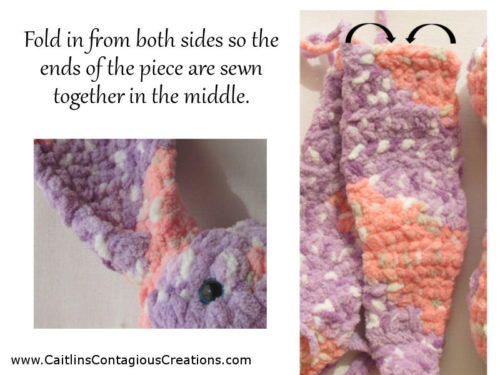
Working Down
After the ear is attached, I move down to the next limb: the arm. When deciding where to attach the arm, Keep in line with the ear and go down to slightly below the most narrow part. The most narrow part of the amigurumi pattern is the neck, usually, so leave a row or two for the “shoulders”.
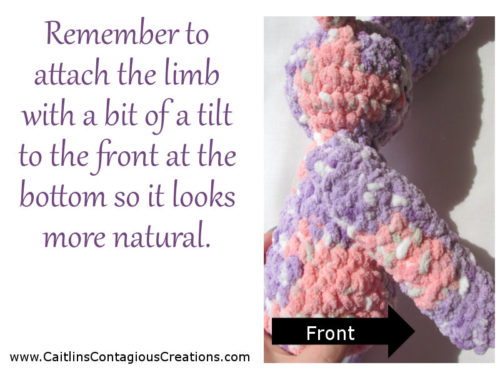
Check your placement from the front as well, make sure the arms are level. This is easiest by simply counting to make sure you attach each arm in the same row on each side.
Last Limb
The last limbs to be attached are the legs. Continue the line you’ve started with the ears and arms down to the bottom of the body. Decide if you want your amigurumi to be able to sit, stand, or both. That may impact where you place the legs, and think about the tail also. Plan for the tail before you sew on the legs.
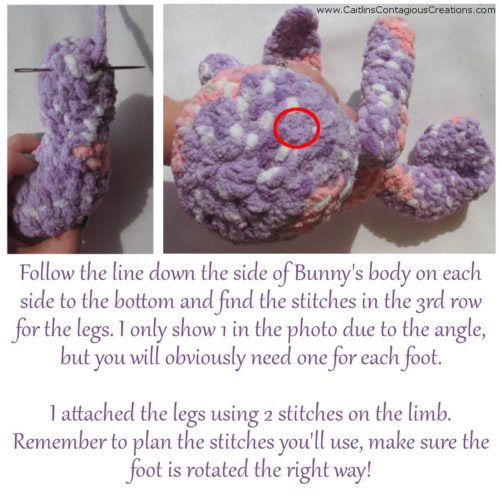

These are websites where I found the most helpful bow tying tutorials (My ribbon skills still need some brushing up, but I think I did an okay job for my first attempt! Actually it took like 4 or 5, but whose counting?)
My Small Addition to the Mix
And because I cannot leave a good pattern alone, I must add that I tweaked this pattern a little…

I added a fluffy tail! I finished with the bunny and thought she just needed a fluffy white tail. Thanks to Linda from the crochet and knitting group I go to on Wednesdays, I had the exact yarn for making bunny tails.

Bonus! The tail helps Bunny sit on her own <3
How To Make Your Own Bunny Tail
Bunny tails are very simple to make, but there is an aspect many people overlook. Kids are not gentle with their things. If I were to give this bunny a simple pom-pom tail, the yarn pieces would be pulled out in no time. Bunny would not only have no tail but the bits of yarn aren’t exactly ideal playthings for your toddler… 😳
My solution is to sew the tail pieces together first so they can’t be pulled apart.

Cut The Tail Yarn
Before you can break out that sewing machine the tedious part… cutting a gaggillion little yarn pieces to length for the tail. I cut my pieces to 3 – 3.5 inches. Some variation is okay because you are going to trim the tail later anyway, but not too much.
Hint: Don’t throw out any that accidentally get cut too small. Having a few will help fluff up the tail!
Depending on the kind of yarn you use, sewing some strips to just each other may or may not be an easy task. An awesome way to complete this feat with any machine is to sew your yarn pieces onto a strip of parchment paper. The paper provides just enough stability that the yarn can be stitched together and it won’t clog up your bobbin!

Sewing Your Tail
After ensuring your needle is up, place the parchment paper under the foot. Add some yarn under to toes of the foot, but not quite under the needle yet.

The trick is to add a few yarn pieces at a time as the needle moves through the paper. You are basically sewing the yarn to the paper…

When you are done sewing the yarn, turn the whole thing over and rip it off the parchment paper.
Roll That Tail Into A Ball!

After your paper is separated start at one end and roll the sewn yarn pieces up like sushi. Try to keep the ends from getting too mingled together. Knowing where the thread line is will help in the next step.

Attach a piece of yarn to match your tail to the needle. Feed the needle through the center of the tail ball along the thread (keeping the tail end out to tie with), feeding the needle back and forth trough the thread when possible. Wrap the yarn around the center axis of the ball and tie it tightly to the end you kept out.

Repeat this sew and wrap process a few times until you feel the yarn ball is secure. Wrap the yarn tightly around the center.
Once you feel the tail ball is tightly wound, tie it off by feeding your needle through the center and tie it off. Leave a long tail so you have something to sew the tail to the body with.
Attaching Your Tail To Bunny
Here is a paper clip (I am running short on stitch markers 😸 my cat thinks they are fun…) showing where the tail will be sewn. I am sewing the tail into 2 stitches in the 4th row up. I am sewing it a little higher than the legs because the poof of the tail would make him sit forward too far if the tail was on the same row as the legs.

When deciding where to sew your tail, picture a line going straight down the center back of bunny’s body to find where the tail should be.
Then just sewn the tail into place. Pass the needle through the tail a couple of times for extra security!
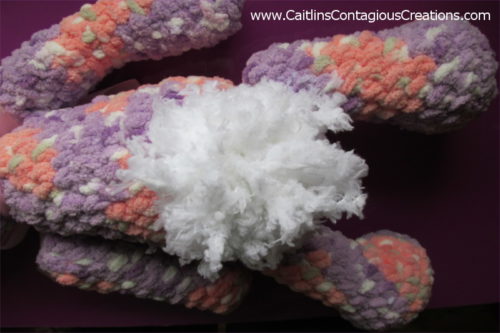
After the tail is on take your scissors and carefully trim the ends of the yarn pieces to make a nice round bunny tail!
Finished Bunny!
Your bunny has a bow and a tail, she is assembled and ready to go! I hope this amigurumi assembly tutorial has helped you not just with this bunny, but with any amigurumi you might be working on.
What color did you make your bunny? Please connect with me on Facebook and show me your creations!
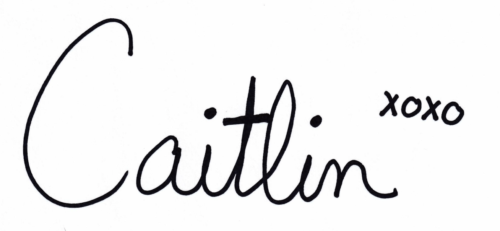



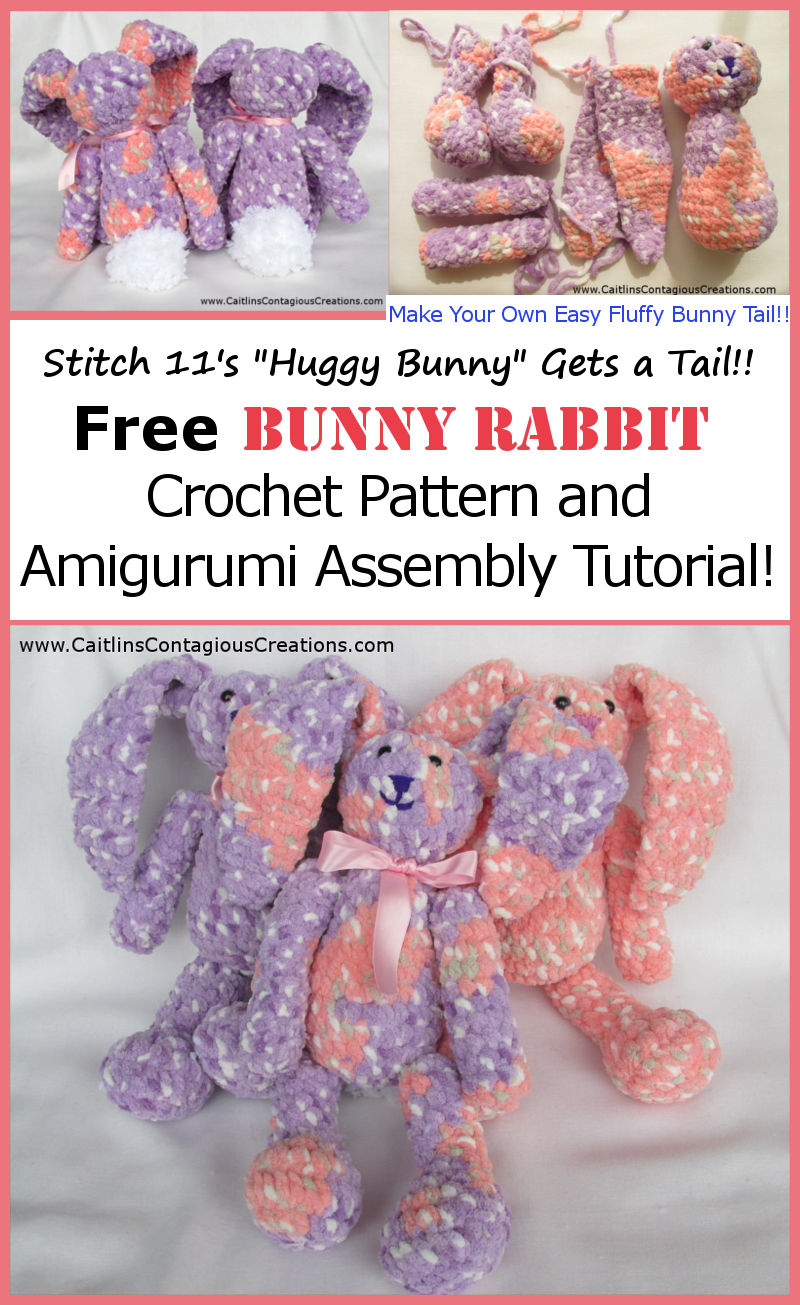







Caitlin do know how to make slipper socks size8 and 9 for woman
Kimberly Silhan
Kimberly, Unfortunately, socks are something I haven’t worked up a pattern for. I would recommend browsing on Pinterest or Facebook for some free patterns to try. If you are looking for a paid pattern, Etsy, LoveCrafts and Ravelry all have some excellent selections. Have fun finding a good one 🙂 ~Caitlin